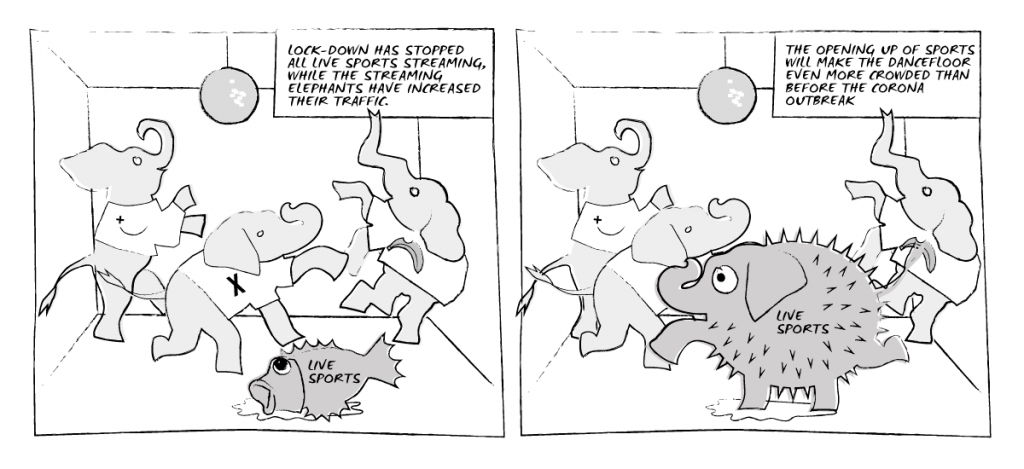Will the return of sports be the collapse of internet?
This spring has been different, in many ways. To control and minimize the pandemic, lockdowns and social restrictions have changed how we live, almost instantly. It has changed how we consume TV and video. In fact, we’re watching more TV than ever. But what we watch and how we watch it is quite different as we spend our time in quarantine exploring the wide and deep catalogues of VOD services.
For some, this change has been good. SVOD giants like Netflix and the new kid on the block Disney+ have onboarded subscribers in numbers well above expected, and streaming figures have risen as a result. For others, the economic set back has eroded advertising budgets drastically with tough consequences for Free To Air (FTA) services. In some places this has resulted in a higher load on the internet, but in most places the actual peaks have not been higher than before.
Sports – which gather audiences in their millions both at venues and via TV – have also been cancelled to help prevent the virus spreading. But as societies slowly open up again, sport will come back, albeit under different circumstances than before. To maintain social distancing, we can expect that our favorite sports will be played with no audience in the stadiums or in the local sports bar. Everyone who wants to experience the event will be referred to the TV. Despite there being fewer sports to watch on TV, we are likely to see sport viewing numbers increase – from the hardcore fans in hats and scarves who have been starved from watching their favorite team live to the general spectator. They’ll all turn to the TV, on whatever device they choose, as their only alternative for consuming sports content.
During the outbreak, streaming service usage via the internet has rocketed. New viewing habits are established in the absence of sports and many other local entertainment formats that are typically watched on traditional TV. This has made viewers cut the cord and turn to – and trust – internet-based streaming services as their go-to source for TV-based entertainment.
This means that when live sport does eventually return, it is going to join at a time when the overall internet traffic load is significantly higher than it was before the outbreak. In other words, the fight for capacity just got even more intense.
The animal kingdom of streaming
In a previous blog, I described the internet as a dancefloor and the streaming services as elephants. In contrast to ordinary nightclubs that are now temporarily closed, the streaming dancefloor is now more crowded than ever. So crowded in fact, that the EU had to ask a couple of the biggest elephants to adopt a (unnecessary blunt) bit-rate limitation diet.
So, with the return of sports, we will probably see an increased demand for live streaming sport events. Yes, we were able to live stream sport events before the pandemic. But with the lockdown stopping all live sports, streaming services will likely experience huge demand once the players can get back on the field.
For this reason, I want to introduce a new animal to join the elephants at the party. Since these animals represent the typical behavior of big live events, such as high traffic peaks during the start of the event, the new addition can be illustrated as blowfishes. Blowfishes have an unpleasant behavior of rapidly changing in size which makes their moves and tricks hard to predict.
What am I trying to get to, you might wonder? Well, this all boils down to the internet’s shared capacity. With another animal now trying to get onto the dancefloor, it has become more crowded, especially over the last four months. The fight for capacity is getting pretty fierce.
I have talked about how different parts of the internet impact the viewing experience in an earlier blog. I’m not so worried about access networks in general, but I’d like to raise a concern about cable and mobile networks as these are typically shared media and thus, can become easily congested. Even more challenging are the backhaul network and peering interfaces with CDNs calling for network upgrade investments and interconnect discussions.
I won’t go into detail about the different parts of the internet and how their technical characteristics dictate potential viewing issues. I will just point out that these play an important role here. It’s become extremely obvious during the last few months that with the internet being a shared resource and the foundation for delivering huge amounts of TV content, there is a need for more comprehensive and real-time means of control. A means where streams can be steered with precision and where actions to manage congestions are done with the network, the content and especially the viewer’s quality of experience in mind.
Johan Bolin, chief product and technology officer at Edgeware
ARE YOU READY FOR TV BEYOND BROADCAST?
Fill out the form below and we will get in touch with you.
